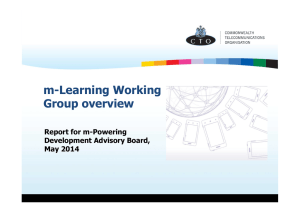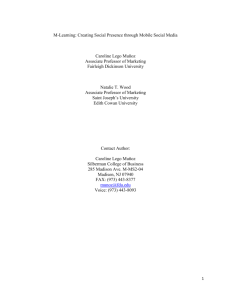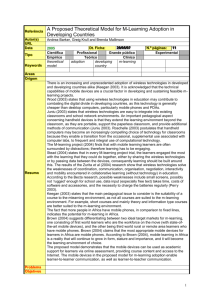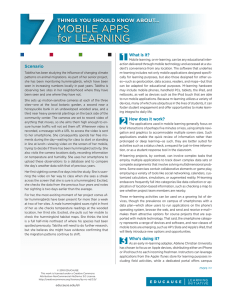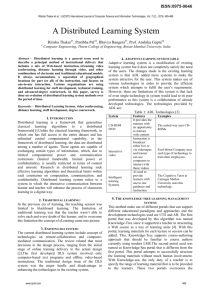M-Learning Adoption Research: Table of Contents
advertisement
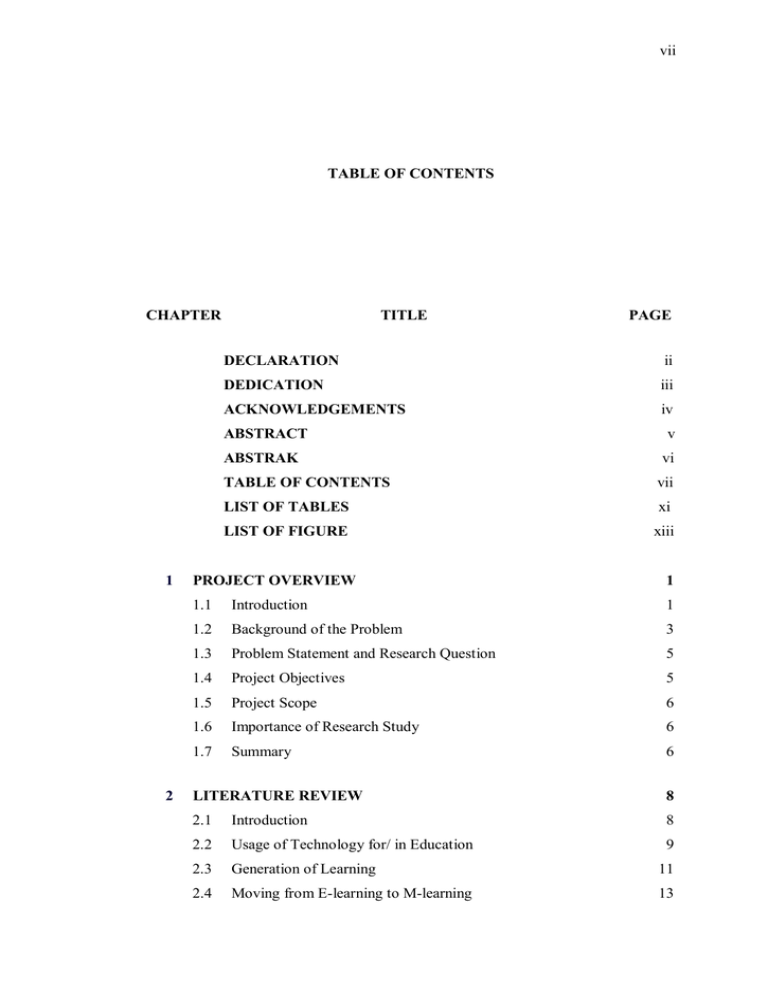
vii TABLE OF CONTENTS CHAPTER TITLE DECLARATION ii DEDICATION iii ACKNOWLEDGEMENTS iv ABSTRACT ABSTRAK 1 2 PAGE v vi TABLE OF CONTENTS vii LIST OF TABLES xi LIST OF FIGURE xiii PROJECT OVERVIEW 1 1.1 Introduction 1 1.2 Background of the Problem 3 1.3 Problem Statement and Research Question 5 1.4 Project Objectives 5 1.5 Project Scope 6 1.6 Importance of Research Study 6 1.7 Summary 6 LITERATURE REVIEW 8 2.1 Introduction 8 2.2 Usage of Technology for/ in Education 9 2.3 Generation of Learning 11 2.4 Moving from E-learning to M-learning 13 viii 2.5 2.6 2.7 2.8 2.9 M-learning 16 2.5.1 Introduction to M-learning 16 2.5.2 Definitions of M-learning 17 2.5.3 Advantages of M-learning 19 M-learning Tools 20 2.6.1 PDAs 20 2.6.2 Pocket PC 21 2.6.3 Cell Phones 22 M-learning Case Studies 22 2.7.1 SMS Technologies for Education in the Philippines 22 2.7.2 Mobile Cell Phone as Educational Tool in Bangladesh 23 2.7.3 Lessons Learned From Case Studies 24 Diffusion Procedure 25 2.8.1 27 Adoption and Individuals’ Differences Technology Acceptance Model (TAM) 28 2.9.1 30 M-learning Adoption Case Studies 2.9.1.1 2.9.1.2 2.9.2 Case Study in University Campuses of New Zealand 30 Case Study in Zhejiang Normal University in China 33 Other M-learning Adoption Models 2.9.2.1 Teresa L. Ju, Wathanaporn Sriprapaipong , Do Nhut Minh Model 35 Jen-Hung Huang ,Yu-Ru Lin, Shu-Ting Chuang Model 36 2.9.2.2 3 35 2.10 Factors Influencing Adoption of M-Learning 38 2.11 Chapter Summary 39 RESEARCH METHODOLOGY 41 3.1 Introduction 41 3.2 Research Location 42 3.3 Research Participants 42 3.4 Research Design 43 3.5 Phase 1(Initial Planning) 46 3.5.1 46 Identify Research Objectives and Problem Definition ix 3.6 Phase 2 (Preliminary Study) 46 3.6.1 Select Basic Research Method 46 3.6.2 Data Collection 48 3.6.2.1 49 3.6.3 3.7 4 Conduct Survey Preliminary Finding Analysis 53 Phase 3(Data Collection and Analysis) 53 3.7.1 Conduct Survey 53 3.7.1.1 Pilot Survey 57 3.7.1.2 Main Study 58 3.8 Phase 4(Discussion and Conclusion) 60 3.9 Chapter Summary 61 PRELIMINARY STUDY 62 4.1 Introduction 62 4.2 Implementation of E-Learning in UTM 63 4.2.1 Reasons of Implementing E-Learning in UTM 63 4.2.2 Vision and Mission 64 4.2.3 Previous and Current Challenges of E-Learning 65 4.2.4 Usage of E-Learning in UTM 66 4.2.5 Plan for Future 68 4.3 Questionnaire Development 69 4.4 Student Questionnaire Analysis 72 4.4.1 Background of the Participants 72 4.4.2 Usage of E-learning 75 4.4.3 Ownership of Mobile Devices and Their Functions 78 4.4.4 M-learning 80 4.4.5 Preferred M-learning Content and Applications 85 4.5 Lecturers Questionnaire Analysis 87 4.5.1 Background of the Participants 87 4.5.2 Usage of E-Learning 91 4.5.3 Ownership of Mobile Devices and Their Functions 92 4.5.4 M-learning 94 4.5.5 Preferred M-learning Content and Applications 98 4.5.6 Main Points of Open-Ended Question 101 x 4.6 Conclusion of Analyzing Questionnaires 102 4.6.1 Interest in Using M-learning 102 4.6.2 Discuss in Ownership of Mobile Devices 103 4.6.3 Discuss in Benefits and Barriers That Encourage and Discourage Users to Adopt M-Learning 105 Preferred M-learning Content 106 4.6.4 5 6 4.7 Proposing M-learning Adoption Model 107 4.8 Chapter Summary 111 DATA COLLECTION AND ANALYSIS 112 5.1 Introduction 112 5.2 Questionnaire Development 113 5.3 Questionnaire Analysis 113 5.3.1 Demographic Information 113 5.3.2 Opinion Related to M-learning 117 5.3.3 Effects of Demographic Variables 127 5.3.4 Conclusion 134 5.4 Recommendations 136 5.5 Chapter Summary 141 DISCUSSION AND CONCLUSION 142 6.1 Introduction 142 6.2 Achievements 143 6.3 Constraints and Challenges 145 6.4 Future Works 146 6.5 Chapter Summary 146 REFERENCES APPENDICES 147 154-167 xi LIST OF TABLES TABLE.NO TITLE PAGE 2.1 Nomenclature comparisons (Refined from Laouris & Eteokleous) 13 2.2 Comparison between Electronic and M-Learning environments Refined from(K.Sharma & L.Kitchens, 2004) 14 2.3 Lesson learned from case studies 24 2.4 Factors influencing adoption of M-learning 38 3.1 Details of research methodology phases 45 3.2 Types of research methods 47 3.3 Krejeie and Morgan list 50 3.4 Number of samples based on sampling method 50 3.5 Item map of questionnaire 55 3.6 Cronbach’s Alpha questionnaire reliability analysis 58 4.1 Number of undergraduate and postgraduate student 74 4.2 Usage of E-learning among students 75 4.3 Discourage reasons of using E-learning based on faculty 77 4.4 Interest in M-learning based on faculty 80 4.5 Possible benefits to M-learning 82 4.6 Possible barriers to M-learning 83 4.7 Course information 85 4.8 Course content 86 4.9 Preferred applications 87 4.10 Educational background of participants 89 4.11 Years of experience in teaching 90 4.12 Years of experience in using E-learning 90 xii 4.13 Usage of E-learning among lecturers 91 4.14 Interest in M-learning based on faculty 95 4.15 Possible benefits to M-learning 96 4.16 Possible barriers to M-learning 97 4.17 Possible barriers of M-learning and differences of faculties 98 4.18 Course information 99 4.19 Course content 100 4.20 Preferred applications 101 4.21 Positive and negative points of M-learning 101 4.22 Main benefits that encourage usage of M-Learning 105 4.23 Main barriers that discourage usage of M-Learning 106 5.1 Questionnaire map and summary of mean for each factor 118 5.2 Regression analysis 119 5.3 Differences between genders based on PEOU 128 5.4 Differences between genders based on PU 129 5.5 Differences between age groups based on PEOU 130 5.6 Differences between age groups based on PU 131 5.7 Differences between faculties based on PEOU 132 5.8 Differences between faculties based on PU 133 5.9 List of recommendations 137 xiii LIST OF FIGURES FIGURE.NO TITLE PAGE 2.1 Mind map of chapter 2 9 2.2 Basic variables of TAM and their relationships (Davis, 1989) 29 2.3 M-learning adoption model(Lu & Viehland, 2008) 32 2.4 M-learning adoption model(Liu, et al., 2009) 34 2.5 M-learning adoption model (Ju, et al., 2007) 36 2.6 M-learning adoption model (J.-H. Huang, et al., 2007a) 37 3.1 Phases of research methodology 44 3.2 Usage of E-learning in UTM based on faculties 49 4.1 Usage of E-learning in UTM based on faculties 66 4.2 Development trends of E-learning 67 4.3 Four main parts of questionnaires 71 4.4 Percentage of participants based on gender 72 4.5 Percentage of participants based on faculty 73 4.6 Percentage of undergraduate and postgraduate participants 74 4.7 Semester of study 75 4.8 Frequency of Using E-learning based on 3 faculties 76 4.9 Discourage reasons for using E-learning 77 4.10 Ownership of mobile devices 79 4.11 Mobile devices’ functions 79 4.12 Interest in M-learning based on faculty 80 4.13 Interest in M-learning for non E-learning platform participants 81 4.14 Possible benefits of M-learning and differences of faculties 82 4.15 Possible barriers of M-learning and differences of faculties 84 xiv 4.16 Percentage of participants based on gender 88 4.17 Percentage of participants based on faculties 89 4.18 Frequency of using E-learning based on 3 faculties 91 4.19 Ownership of mobile devices 93 4.20 Mobile devices’ functions 93 4.21 Experience in using M-learning 94 4.22 Interest in M-learning based on faculty 95 4.23 Possible benefits of M-learning and differences of faculties 96 4.24 Proposed model 110 5.1 Percentages of participants based on gender 114 5.2 Percentages of participants based on age groups 114 5.3 Percentages of participants based on experience in using E-learning 115 5.4 Ownership of mobile devices 116 5.5 Ownership of mobile devices with internet access ability 116 5.6 Length of time accessing the internet from mobile devices 117 5.7 Regression analyse results 121 5.8 Percentages of PUE’s items 123 5.9 Percentages of PEOU’s items 124 5.10 Percentages of PU’s items 124 5.11 Percentages of SE’s items 125 5.12 Percentages of AT’s items 126 5.13 Percentages of PMV’s items 126 5.14 Percentages of BI’s items 127 5.15 Final M-Learning adoption model 135


